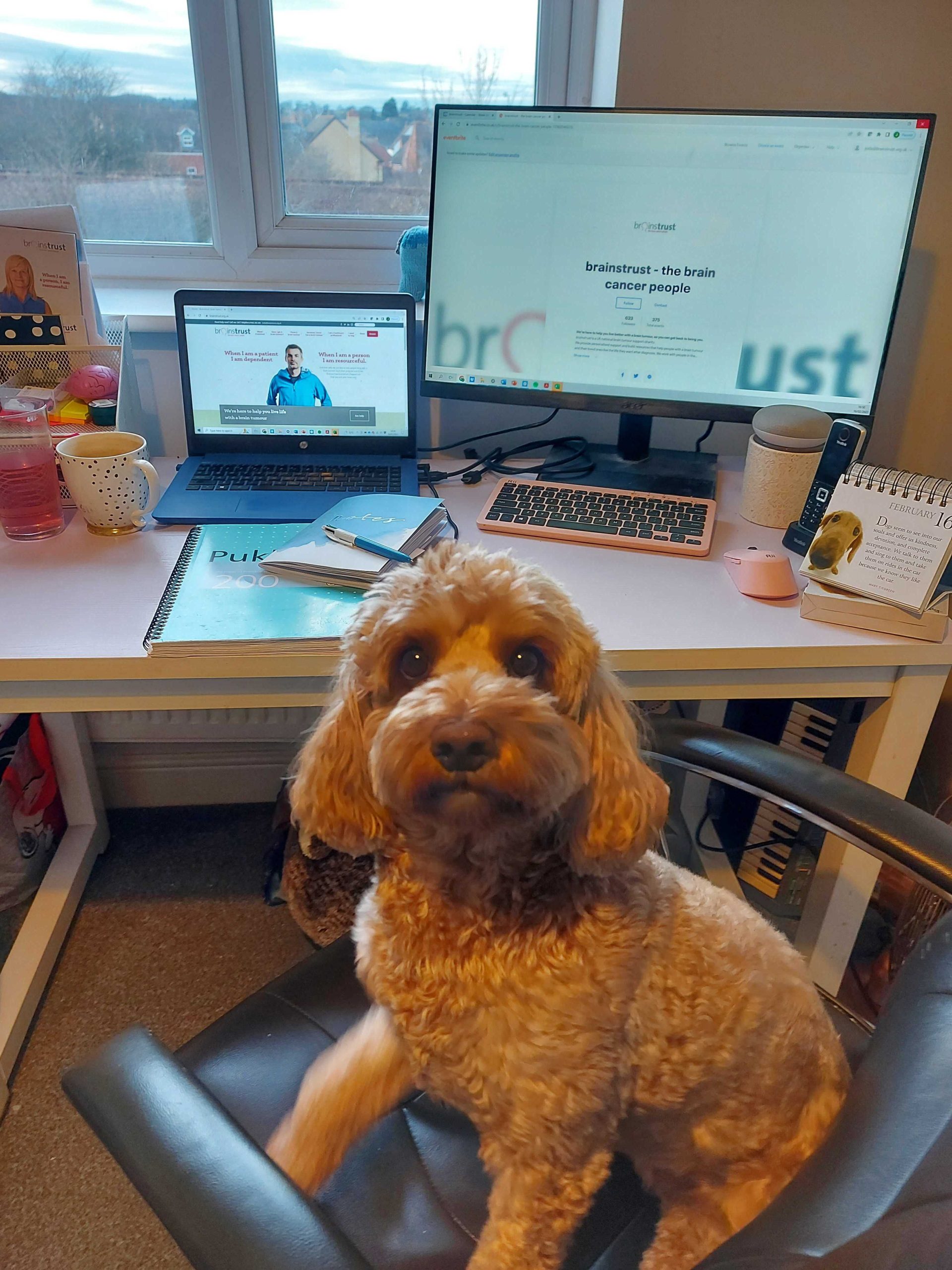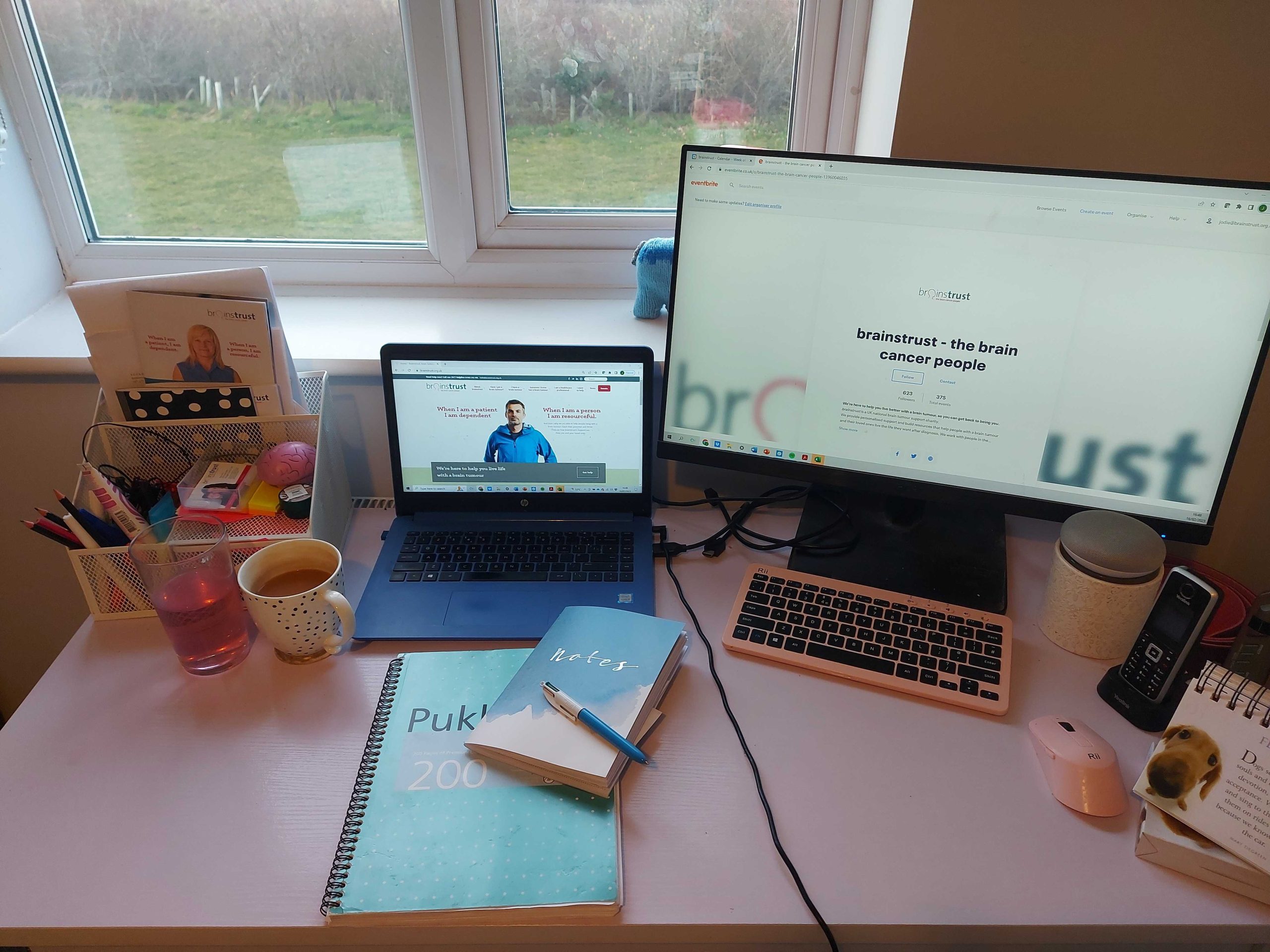Hello! I’m Jodie, the Head of Support and Support Specialist for the Midlands at brainstrust. I am based at home in Lichfield, Staffordshire, occasionally assisted by my lovely dog Roxie- although she isn’t up to much as far as a helping hand with work goes! I joined brainstrust in December 2017 with a passion for wanting to support people to navigate their way through the life changing news of having a brain tumour diagnosis.
During my time at brainstrust, I have been incredibly privileged to connect with so many of you, both from the Midlands region and other areas as well- thanks to the power of zoom! Aside from this, one of the other things that I really enjoy about my role is the opportunities to get involved in so many different projects. The brainstrust Support team is a small (but hugely productive) team of 7 who are responsible for delivering everything related to our support service. This includes our information production, events coordination and facilitation, coaching service as well as responding to emails and calls that come through our helpline. As a charity we balance being proactive with being reactive and being there for people when they need us the most.
Join me below as I talk you through what a day as Jodie at brainstrust can look like:

Midlands Suppawt Specialist, Roxie
8:45 – 9:00 am – After feeding Roxie (8am on the dot) and having a couple of morning coffees, it’s time to get to my desk and open up my laptop ready to start the day.
9:00 – 9:30 am – I spend about half an hour checking through my emails and responding to anything that may have come in overnight. We have received a couple of new brain box requests from a patient and a caregiver so I get in touch with them and organise for their boxes to be sent out. All of our brain boxes are put together and sent out by Ellie, our wonderful Resources Officer who is based in our Leeds office.
9:30 – 10:45 am – I have a coaching call with Lorna* on our Thrive platform. Lorna was diagnosed with a Meningioma in 2019 and is struggling with the side effects of radiotherapy treatment that she had last year. We talk through what is happening at the moment and where she feels she wants to be. We talk through the impact that fatigue is having on her to day-to-day life and talk through some strategies that she can implement into her daily routine. We identify what some of her key values are which underpins our coaching conversation about why the fatigue is impacting in the way it is and using these values to prioritise the management of it. Lorna expresses that things feel a lot clearer now and she feels she has a good way forward. We plan to speak again in two weeks time.
10:45 – 11:15 am – I update my availability on the Thrive platform for my next call with Lorna and send her some follow up notes following our call. Then it is time for a cup of tea (and maybe a biscuit) before my next call at 11.30am.
11:30 am – 12:15 pm – I have a call with Rosie, the brainstrust Support Specialist for Wales, Bristol and Liverpool to plan an upcoming Fatigue webinar. Rosie is relatively new to the Support team having joined in September 2022 and this is the first time she has ran a coaching webinar. We go through the format of the session, decide who is going to lead on which section and discuss a plan for contacting attendees ahead of the session and following on from it. We both come away with actions to work on the presentation ahead of the webinar.
12:30 – 2:00 pm – Following from a morning of different calls, I spend some of the afternoon going back and checking in with emails that have come in. I have some emails from patients and caregivers that I am in regular contact as well as a request to arrange a call to find out more about our coaching service. I schedule a call in with this patient for two days’ time.
During this time, I also take some time to review one of our information resources that needs updating. All our information resources have to go through a content and design review every 3 years which is done by a member of the support team alongside patients and caregivers. I send the suggested changes to Catherine our Designer who will put these into place ready for me to check over before they are proofread, signed off and then reprinted.
I then take a look at planning my monthly regional broadcast that goes out at the start of each month and deciding which content I want to include in it.
2:00 – 2:30 pm – I take a call on our helpline from John*. His father has recently been diagnosed with a GBM4 and is currently recovering from surgery. He is due to go visit him tomorrow and is worried about what to expect from the visit and how his father will be. We talk through what about the visit is worrying him, what he knows and what he wants to know. We talk about the support that is available and I make a note to follow up with an email signposting to our know how on ‘living with uncertainty’ and our online meetup for family and friends of people with a brain tumour diagnosis. John is based in London, so I have made a note for Molly, our Support Specialist for London and the South East to check in with him in a weeks’ time. In the meantime, he leaves feeling more supported and informed and knows he can get in touch with us when he needs to.

My home office set up
2:30 – 3:15 pm – In my capacity as the Head of Support, I have a one-to-one with Carol, our Support Specialist for Scotland. We have a chat through Carol’s current workload, and she updates me on some projects she is working on. Carol leads on organising our online events programme so we talk through what is coming up with that respect and start to plan the next couple of months. The support team are all home based across England, Scotland and Wales so making sure we keep in contact on a regular basis through one-to-ones and also more informal channels like slack and WhatsApp is key to helping us feel connected with each other and work effectively.
3:15 – 5:00 pm – For the rest of the afternoon I follow up with various bits and piece on my to do list. I have had a request from a caregiver who would like to be connected with one of our peer supporters, so I take a look at our database to see who would be a good match and message Laura, our Support Specialist for Central Southern England who leads on our Peer Support Programme.
We are currently putting together a new leaflet to advertise our coaching, counselling, and hypnotherapy services so I make a start on writing the copy for that and preparing for our next meeting to put it all together.
I have a lot of different projects on the go at the moment, so I take a few minutes to go through what my priorities are for these over the next week or so.
I am running an online meetup later on in the week so I send an email to our regular attendees with the zoom link and set up emails on Eventbrite so everyone has access to this.
The following day I am away from my desk at a meeting with a regional Cancer Alliance so I make sure I am up to date to make the return to my desk the day after a bit easier.
Before I log off for the day I do a check in on our Facebook support group to take a look at recent posts and where necessary reply to people.
5:00 – 5:20 pm – I take a call from Liz* who I have been in contact with for a number of years. She has had her latest scan results and just wants to have a chat through it with me as she is feeling a bit anxious. We talk through where she can find her moments of calm and she comes away from the call feeling glad that she reached out. She will email me when she wants to talk again.
5:20 – 5:30 pm – I do a quick check of my calendar and reply to any remaining emails and log off for the day. Time to take Roxie for a walk!
*Names and certain details have been changed to protect the privacy of the individual.
There is no such thing as an ‘average’ day at brainstrust (which is one of the things that I love). Our job is varied and busy but above all important. We couldn’t do the job we do without the support of our wonderful community, and for that, we are all so grateful.





